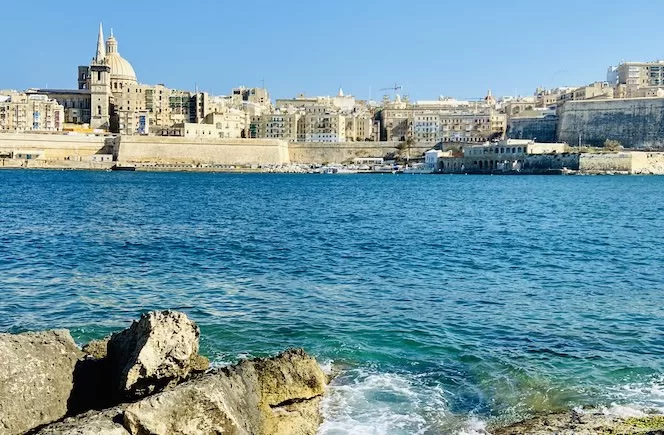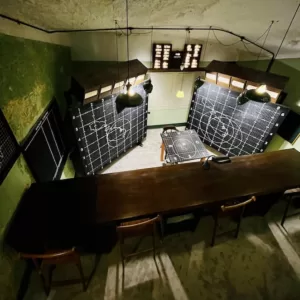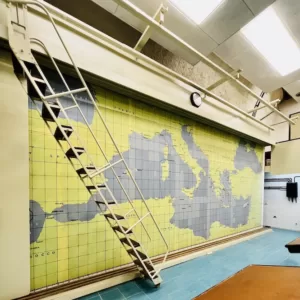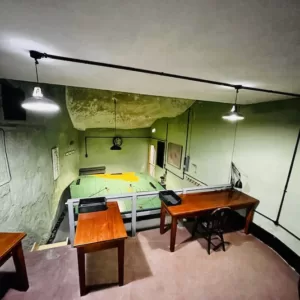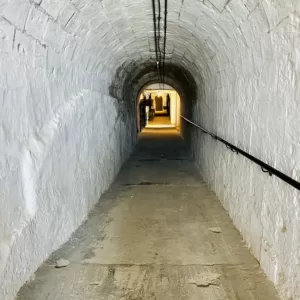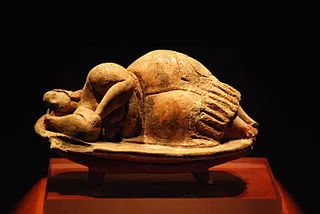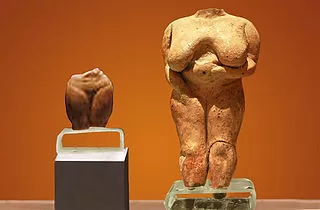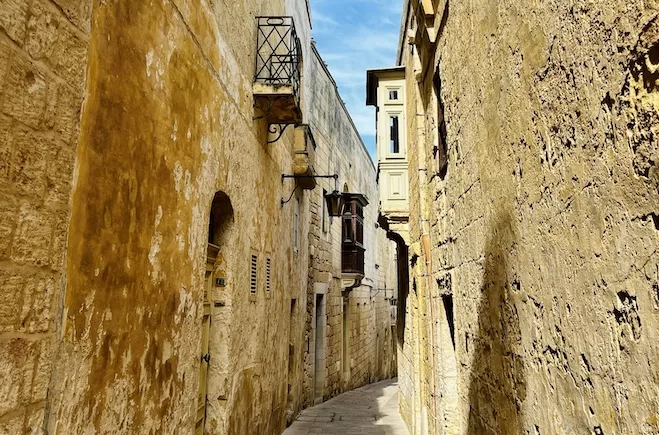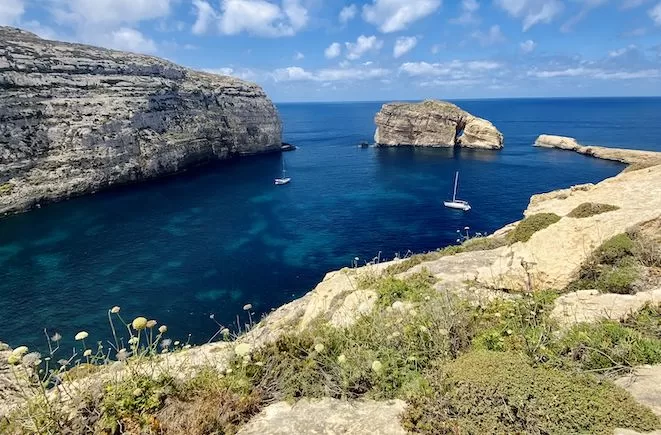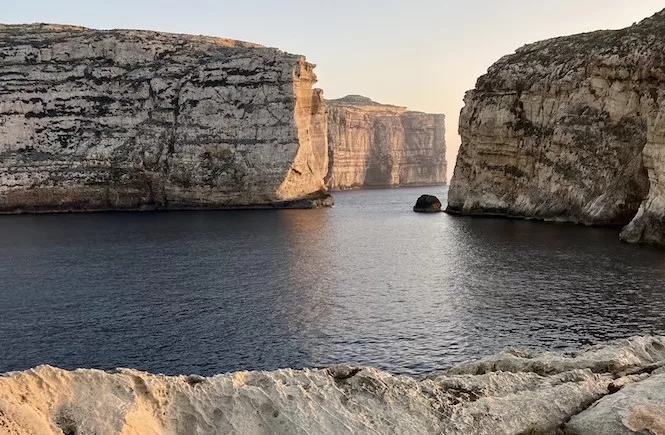Just a quick heads up – some of the links I share on this site are affiliate links. That means if you click on one and make a purchase, I may earn a small commission at no extra cost to you. Your support through these links helps me create valuable content.
What to do in Valletta, you ask? Malta’s capital, Valletta, is amazing, and you should take your time to explore it all. This city is rich in history and it’s surrounded by the Mediterranean Sea views from every corner.
Since 2011, I’ve called Malta home. I love its history and natural beauty. And as a seasoned traveller who has visited every continent, I understand the value of a well-planned holiday.
This article will guide you on what to do in Valletta to make the most out of your stay there. You will find a list of must-see locations. It includes their key highlights and pins on Valletta Google Maps for easy navigation. I’ll also provide a self-guided walking tour map to explore the city at your own pace. And if you need a break from sightseeing, I’ll give tips on finding lovely places to relax.
With this guide, you’ll be able to make the most of your time in Valletta. So check out this blog and put on your walking shoes. You will be amazed by all that this ancient city has to offer.
The Self-Guided Valletta Walking Tour Map
Below is a self-guided Valletta walking tour map that will show you what to do in Valletta. In the city, you will see quite a few stands with a tourist map of Valletta. But it’s better to use the online map; it’s more convenient.
You can fit in and see all the attractions on this map of Valletta in one day. But if you don’t want to rush, you can also break it down into a two-day tour.
If you’re tight on time, include these places to your Valletta one day itinerary:
- Triton’s Fountain
- Upper Barrakka Gardens
- Republic Street
- Grandmaster’s Palace
- St. John’s Co-Cathedral.
These are the top Valletta spots you definitely shouldn’t miss.
The tour is about 4 kilometres long, and the walking should take over one hour. Please note that most attractions close around 5 pm, so it’s best to start early.
If you want to understand Malta’s history well, take a guided walking tour in Valletta. Look at my guide for the best Valletta walking tours.
What to Do in Valletta: Take a Photo next to Triton’s Fountain
The self-guided walking tour focuses on must-see sites in Valletta. It starts at Triton’s Fountain, marked as 1 on the Valletta sightseeing map. It just outside the City Gate of Valletta.
Must-See: A trip to Valletta isn’t complete without seeing Triton’s Fountain.
I remember the first time I saw Triton’s Fountain. Three bronze tritons, strong and graceful, held up a massive basin against the blue Valletta sky.
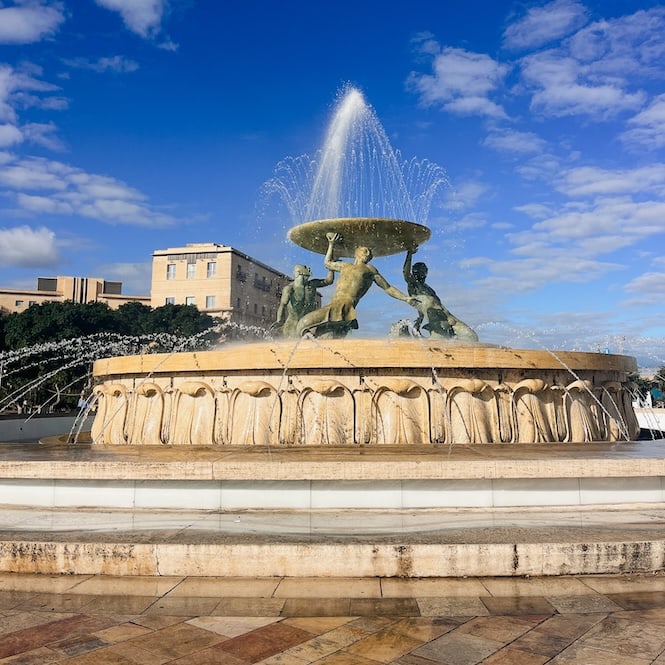
During the day, the fountain was sparkling in the sun. At night, its lights transformed it, making the whole place feel magical.
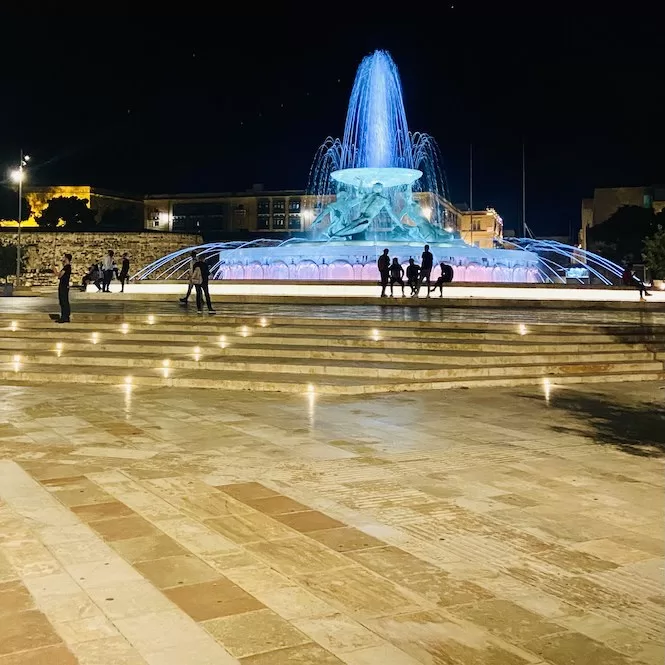
Insider tip: The best view of the fountain is from Hastings Gardens.
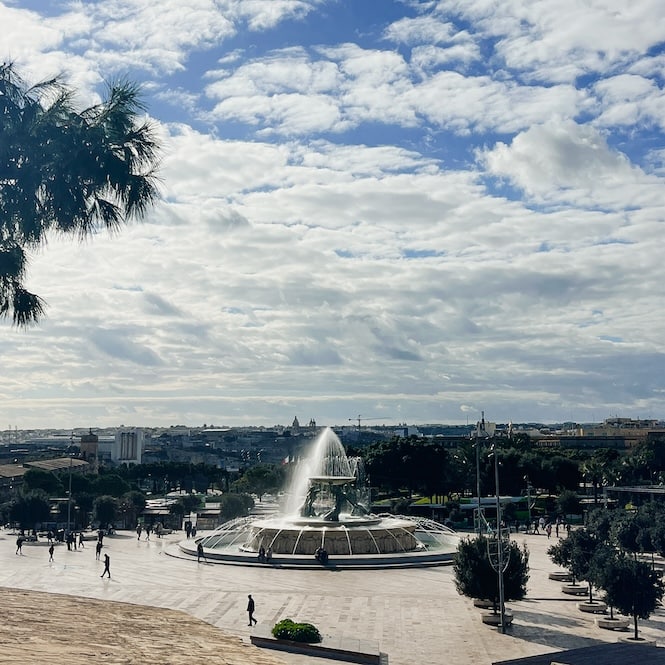
Enter via Valletta’s City Gate
Walk straight from the Triton Fountain and you’ll soon come across a bridge leading to the new City Gate. It’s number 2 on the map of Valletta.
This gate was built alongside the new Parliament House.
Crossing this bridge, you’ll go over the old Valletta ditch. It is now transformed into the lovely Ġnien Laparelli garden.
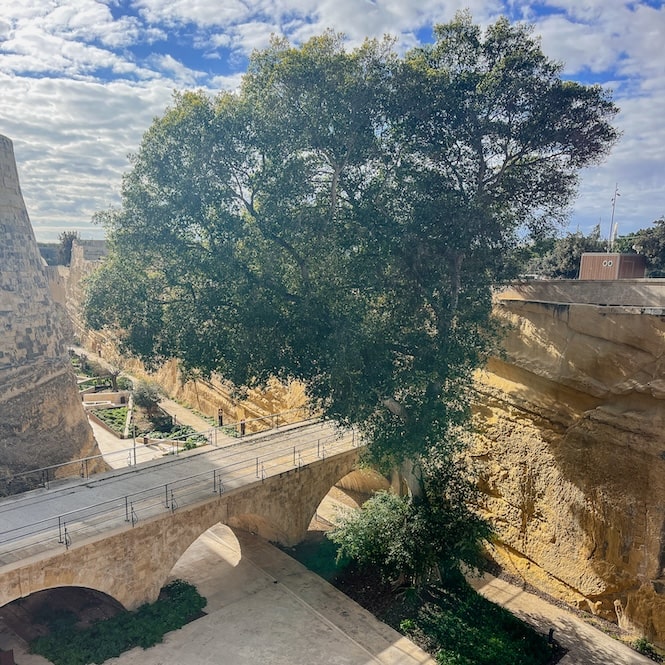
The original gate, constructed by the Knights of Malta, was destroyed in World War II. Back in the ’60s, they replaced the bridge with another one, but people didn’t like it.
Now there’s a new, minimalistic bridge designed by a famous architect Renzo Piano. It matches the Parliament’s style. On both sides of the gate, you’ll see two poles. They symbolise swords held upright, saluting everyone entering the city.
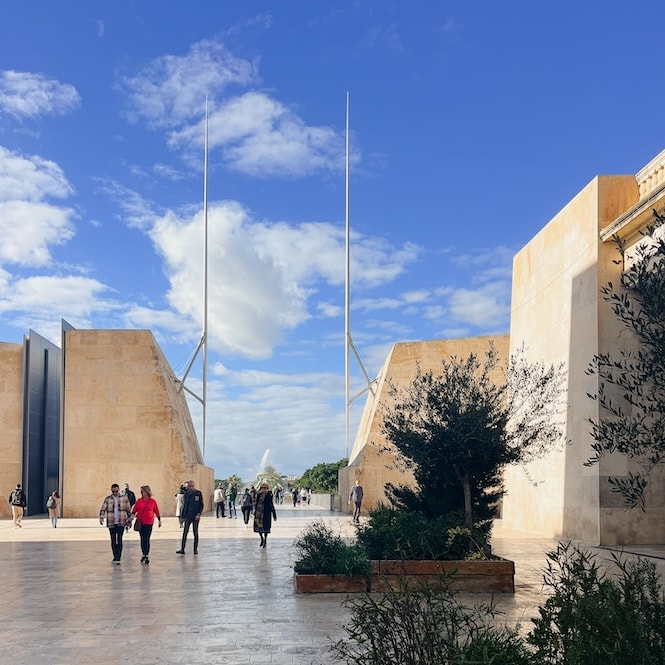
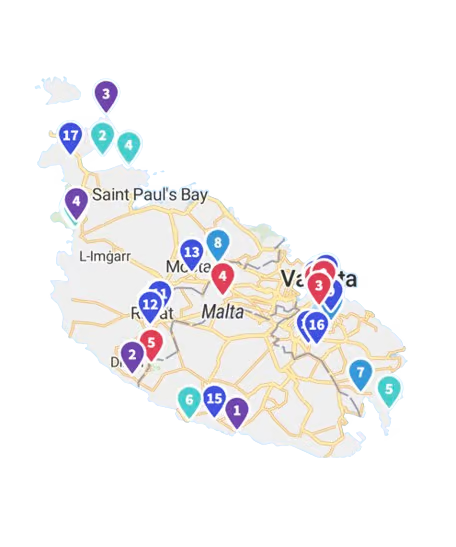
Get a FREE Attractions Map
Planning a trip to Malta, Gozo, or Comino? Get this free interactive map filled with insider tips, Google Maps links, and more.
Admire the New Parliament House
Opening times: Occasionally open for visitors, usually during city events
Location: Google Maps
After you cross the city gate, on your right is the Parliament House of Malta. On the Valletta self-guided tour map, it’s labelled as number 3.
It is a striking modern structure designed by Renzo Piano. It stands as a symbol of Malta’s contemporary architectural vision.
The Parliament House was built between 2011 and 2015. It replaced the old railway station, which wasn’t in use since 1931.
Before its opening, Malta’s parliament met in the Grandmaster’s Palace.
The building has two separate blocks linked by bridges. It is built using Gozitan limestone, concrete, and steel. Its cladding, resembling honeycombs, reflects Malta’s name origins related to honey.
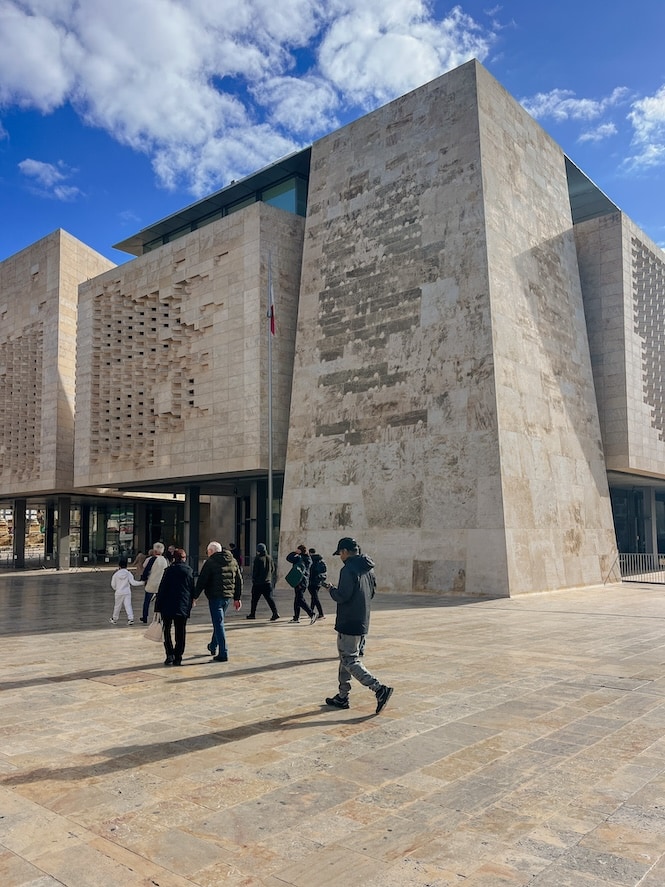
Visit the Upper Barrakka Gardens
Opening times: daily, 7 am to 10 pm
Entrance fee: Free
Location: Google Maps
Must-See: A trip to Valletta isn’t complete without seeing Upper Barrakka Gardens.
After visiting the fountain, head to the Upper Barrakka Gardens. The Valletta self-guided tour map marks it as number 4.
The gardens are one of the most popular attractions in Valletta. Located on the top of the Valletta bastions, they offer stunning panoramic views of the Three Cities.
The Upper Barrakka Gardens were built in the 16th century by the Knights of St John. They were used as private gardens by the Grand Master and the Knights of St John.
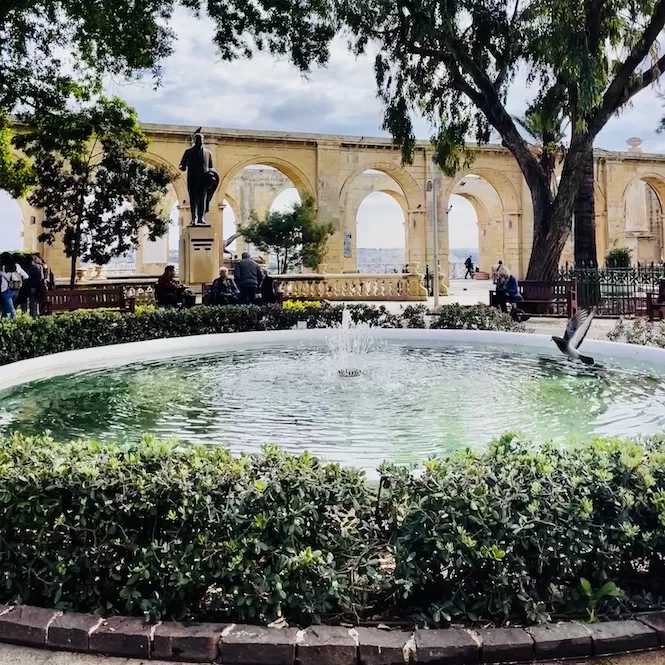
Today, upper Barrakka Gardens are a must-see for visitors to the city. You can enjoy the views from the gardens and be part of the historic gun salute. This place is also reached by a lift, making it accessible to all visitors. The ride goes from the ground level to the top of the gardens.
Explore War HQ Tunnels and the Saluting Battery
The Saluting Battery
The Saluting Battery is next on our Valletta self-guided walking tour, marked as 5 on the Valletta attractions map. It’s a historic landmark that dates back to 1565.
Opening times: Saluting Battery is open Monday to Saturday from 10 am till 4:30 pm (more details)
Guided tour fee: €3 for adults
Location: Google Maps
It was used to announce the opening and closing of the city gate at sunrise and sunset and to fire a signal shot at noon. It also served a ceremonial purpose, saluting ships and special guests as they arrived and departed.
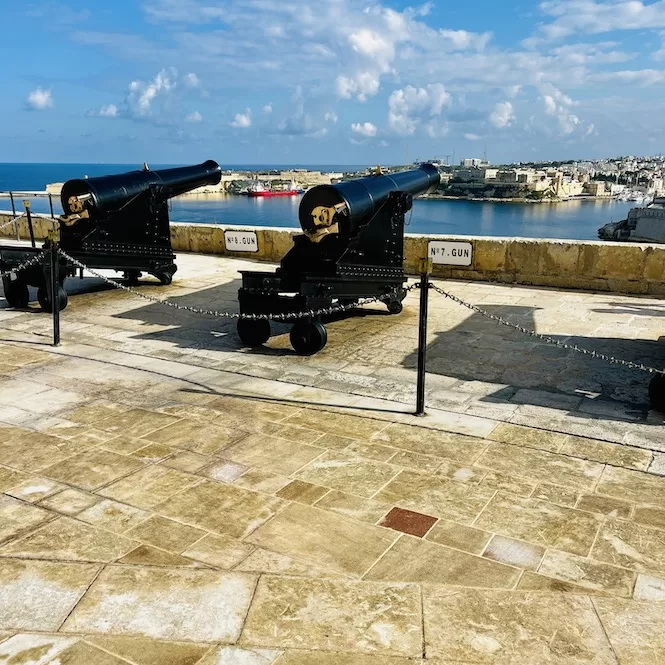
In 1954, the British Royal Navy closed the Battery and removed the cannons. In 1965, after Malta gained independence, the former Battery was converted into a public garden.
Eight replicas of 32-pounder cannons were installed in 2011. Since then, there have been regular salute shoots at 12 noon and 4 pm daily and for special state guests.
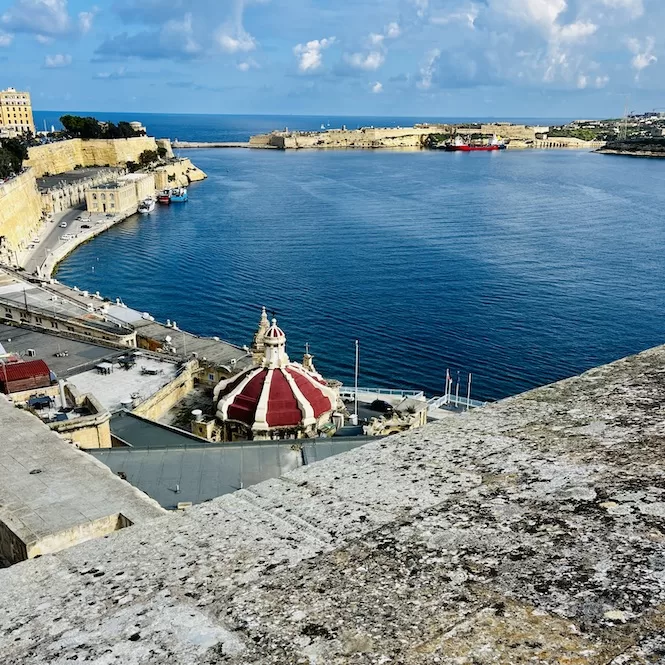
War HQ Tunnels
Opening times: The War HQ Tunnels organise guided tours at 11 am, 1 pm and 2:30 pm from Monday to Saturday (more details)
Guided tour fee: €17 for adults
Location: Google Maps
The most interesting rooms are:
- Anti-Aircraft Gun Operations Room. In this room, the Royal Artillery controlled the anti-aircraft guns. It coordinated the operation with the air defence system.
- Filter Room. The radar data was combined from several stations to get accurate incoming aircraft information.
- NATO Operations Rooms. NATO used this secret room to track Soviet submarines in the Mediterranean.
After the British military left Malta in 1977, the War HQ Tunnels were closed. They remained untouched for a long time.
In 2009, a non-profit Heritage Foundation, Wirt Artna, started restoring the site and offering guided tours. To visit the War HQ Tunnels, you must book a tour. The price includes visiting the Saluting Battery.
What to Do in Valletta: Learn about Lascaris War Rooms
Opening times: Monday to Saturday, 10 am to 4:30 pm (more details)
Entrance fee: €14 for adults
Location: Google Maps
Next on our list of what to see in Valletta, is the Lascaris War Rooms (refer to point 6 on the map of Valletta).
They are next to the Upper Barraka Gardens and the Saluting Battery. The War Rooms are an underground labyrinth of tunnels and chambers.
The Lascaris War Rooms served as Britain’s War HQ in Malta during the Second World War. The military was planning and managing Malta’s defence in this ultra-secret complex.
The army also used these rooms to coordinate other operations in the Mediterranean. At some point during the Second World War, more than one thousand people worked in the War Rooms.
The tunnels have many rooms. Some of the important ones include the RAF sector fighter control room. It was used to monitor and manage all air and sea operations. The artillery fire against air raids was organised in the anti-aircraft gun operations room.
Some rooms housed encryption machines for secret communications.
To get the most out of your visit, get a guided tour.
Relax at the Lower Barrakka Gardens
Opening times: Monday to Sunday, 7 am to 9 pm
Entrance fee: Free
Location: Google Maps
The Lower Barrakka Gardens are next on our walking tour of Valletta. On the Valletta self-guided tour map, it’s labeled as number 7. There you can have a nice break.
The Gardens are only 15 minutes on foot from the Upper Barrakka Gardens. They are a charming part of the history and culture of Valletta.
These gardens are quieter than the Upper Barrakka Gardens. Yet, the views are breathtaking! They are on the top of the Valletta bastions. So, you can see the Valletta breakwater and the Three Cities – Senglea, Birgu and Cospicua.
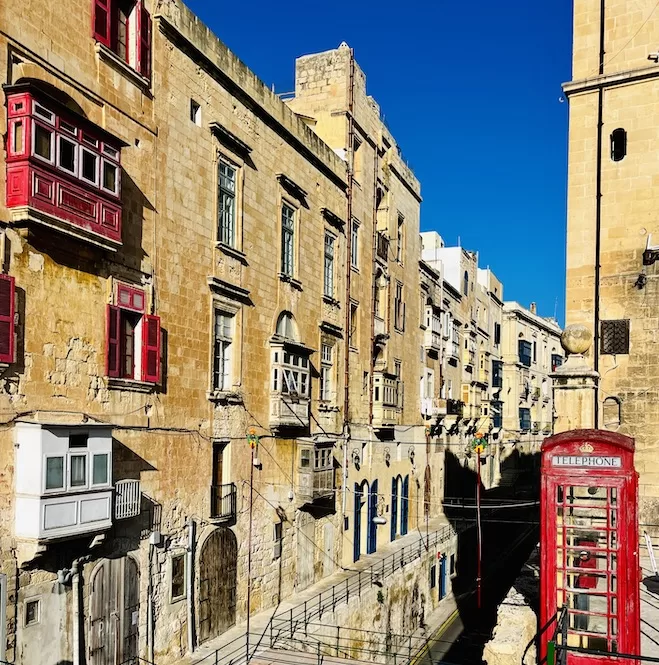
It is best to get there by walking through a beautiful street called St Barbara Bastion.
On the way, you’ll see an old British phone boot and a house with red balconies that are very Instagrammable. You’ll also see old houses that have been beautifully restored.
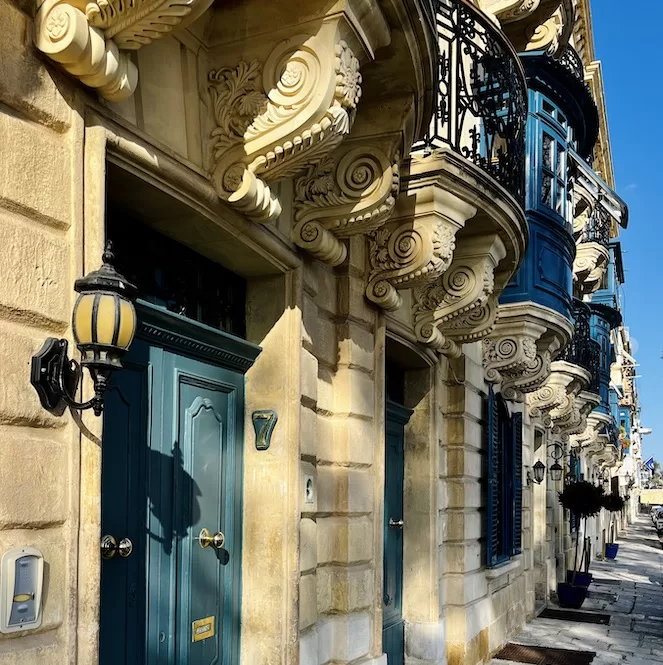
The Lower Barrakka Gardens are my go-to spot in Valletta for quiet time. Sometimes, I find myself there, book in hand, lost in its peaceful atmosphere. It’s also an ideal place for a chat with a friend.
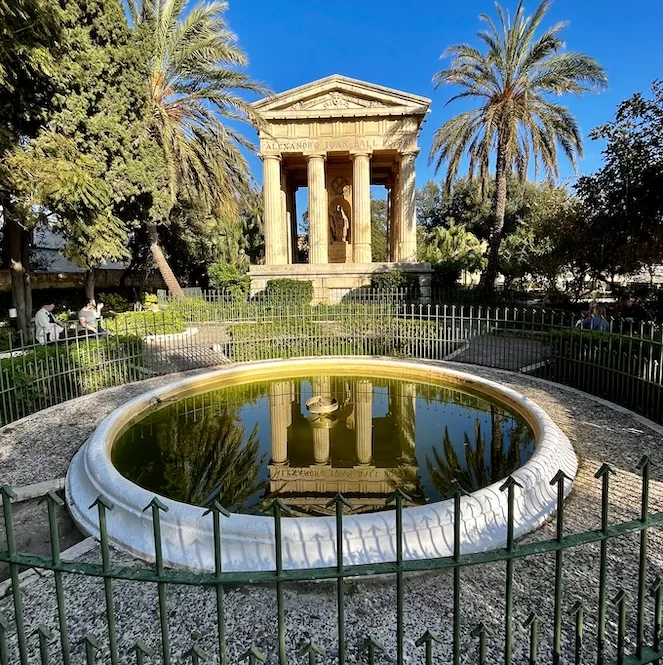
Nearby, there’s a small cafe where you can grab a coffee or a light bite and enjoy the views.
If you like parks and gardens, visit my guide to the best gardens in Malta.
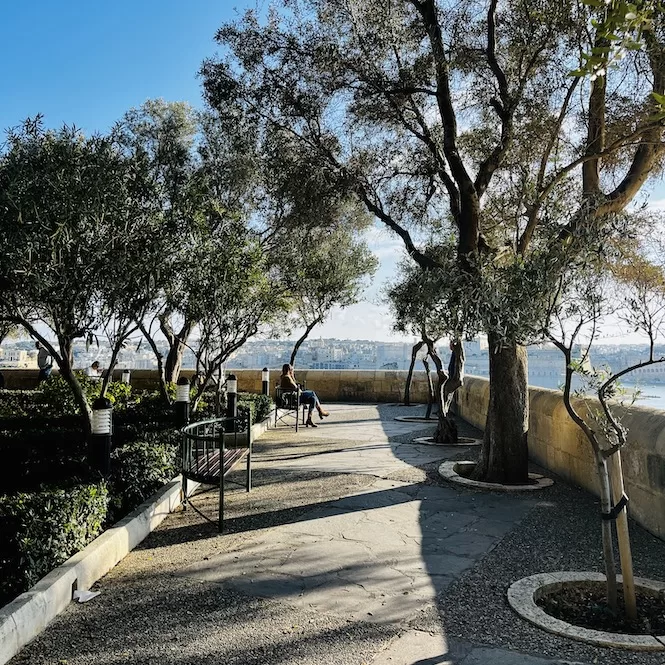
What to Do in Valletta: Discover Fort St Elmo – National War Museum
Opening times: Wednesday to Monday, 9 am to 5 pm in Jan & Feb and 10 am to 6 pm from Mar to Dec.
Entrance fee: €10 for adults, discounts provided for seniors, students and children (more details)
Location: Google Maps
Fort St Elmo, also known as the National War Museum, is another must-see museum in Valletta (refer to point 8 on the street map of Valletta). Don’t miss it if you want to learn more about the island’s rich military history.
The fort is located in the eastern part of Valletta. It was built in the 16th century to protect the harbour from foreign invasions. It has since been restored and maintained to its former glory.
Upon entering the fort, you can enjoy a stunning panoramic view of the harbours and the Three Cities. Inside the fort, you will find a variety of exhibitions about the many battles that took place in Malta.
The museum is split into six parts. It chronicles 7,000 years of Malta’s military history, from the Bronze Age till the 21st century. It houses various weapons and uniforms, photographs, and documents from different eras.
Many events are organised in the fort throughout the year. They include re-enactments of famous battles, living history weekends, and guided tours. These events give visitors a unique opportunity to learn more about Malta’s military history in a fun and engaging way.
The fort can be reached by bus or on foot. It only takes about an hour to explore the entire site.
Visit Casa Rocca Piccola
Opening times: Monday to Saturday, 10 am to 5 pm
Entrance fee: €9.50 for adults, discounts provided for students and children (more details)
Location: Google Maps
Next on our Valletta self-guided walking tour is Casa Rocca Piccola, marked as 9 on the Valletta map. It’s definitely on the top of the list of things to do in Valletta.
This privately owned house has a fascinating history that dates back to the 16th century, the time of the Knights of St John. Today, it’s an important historical site and a popular tourist destination.
The palace has more than fifty rooms, including two libraries, two dining halls, multiple drawing rooms, and a chapel. Most of these rooms are accessible to the public.

If you are eager to learn the customs and rituals of the Maltese aristocracy, then Casa Rocca Piccola is the place to go. It is filled with beautiful furniture, silver, and artwork from Malta and Europe.
Additionally, it has the most extensive private collection of antique garments in Malta. Moreover, visitors can get an exciting experience by visiting the World War II air raid shelters.
Those wanting to explore Casa Rocca Piccola should expect to spend an hour. I also recommend taking a private tour. Book one here.
What to Do in Valletta: Check out Teatru Manoel
Opening times: Monday to Friday at 11 am and 3 pm. Saturdays at 10:30 am, 11:30 am and 12:30 pm.
Entrance fee: €5 for adults (more details)
Location: Google Maps
Baroque-style Teatru Manoel is one of the oldest theatres in use. On the Valletta map, it’s marked as number 10.
Teatru Manoel name comes after Grand Master Fra António Manoel de Vilhena. He commissioned the construction of the theatre in 1732.
The Maonel theatre is a beautiful gem, but not that popular with tourists. However, tours are available, taking visitors through the theatre. You will also visit the museum attached to the building of the theatre. It displays the history and other interesting information about the Teatru Manoel.
Part of the museum is also devoted to the Royal Opera House, which was ruined in a WWII air raid.
Scroll Republic Street
Must-See: Include Republic street in your Valletta sightseeing list.
Republic Street in Valletta is a must-see for anyone visiting Malta (refer to point 11 on the map).
This street is home to stunning Baroque buildings, churches and other architectural wonders. It is a great place to explore and appreciate the history of Malta. The Grandmaster’s Palace and the Auberge de Castille are famous buildings on Republic Street.
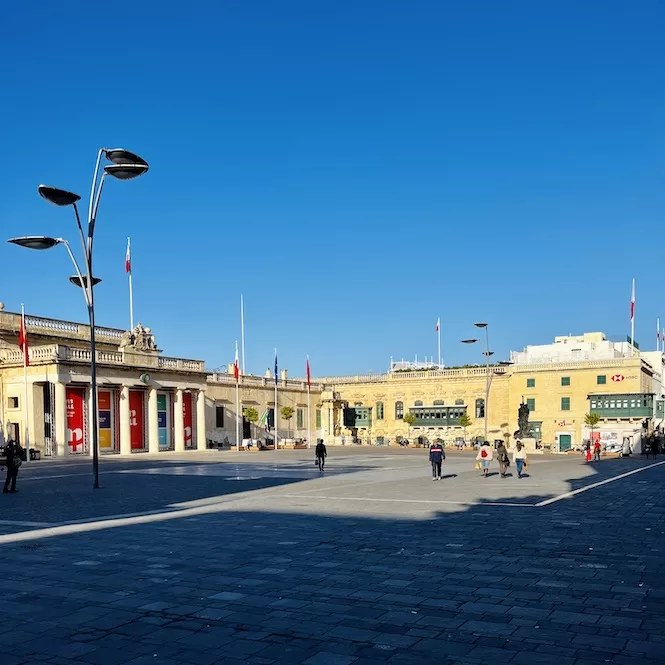
Apart from admiring the architecture, there are plenty of other things to do on Republic Street. Stroll down the street and explore the many shops, cafes and restaurants.
Experiencing the vibrant atmosphere of Republic Street is amongst the best things to do in Valletta. Locals and tourists are often out and about, enjoying the street’s lively vibe. During the summer, there are plenty of street events such as concerts, open cinemas or art exhibitions.
Visit Grandmaster’s Palace
Opening times: Monday to Sunday, 10 am to 6 pm
Entrance fee: €12 for adults, discounts provided for seniors, students and children (more details)
Location: Google Maps
Must-See: A Valletta sight you shouldn’t skip.
The Grandmaster’s Palace (labeled as number 11 on the Valletta map) is a key piece of Malta’s history, originally built for the Grand Master of the Order of St. John. It’s been a multi-purpose building, even serving as Malta’s Parliament.
Its architecture is a mix of Mannerist and Baroque styles, reflecting the changes it’s undergone. After being closed for major renovations, it reopened in early 2024.
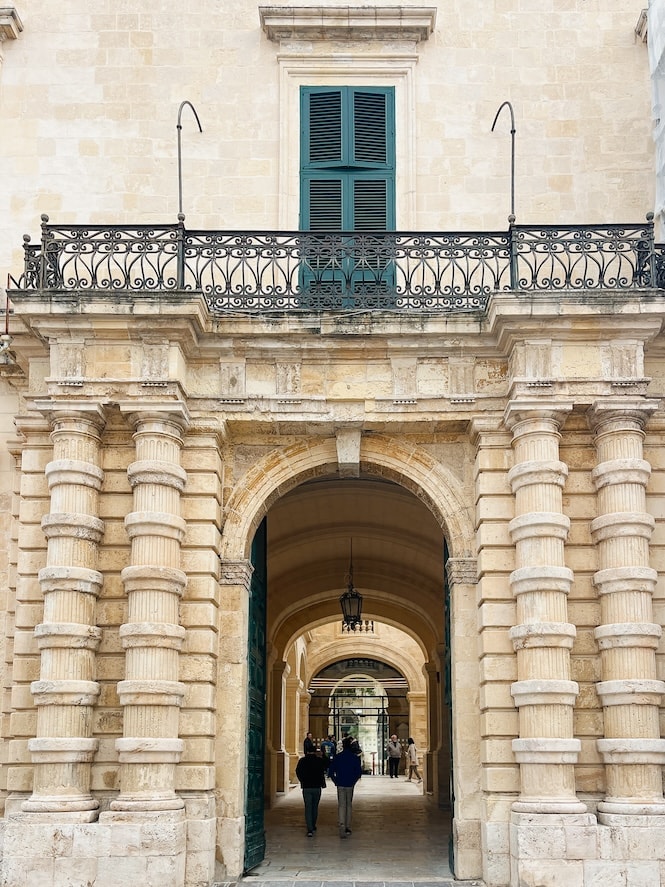
The renovation has brought back its old grandeur. When you’re in Valletta, the opulent state rooms and the impressive armoury in the Palace are definitely worth a visit.
What to Do in Valletta: Get Astonished by St. John’s Co-Cathedral
Opening times: Monday to Saturday, 10 am to 4:45 pm
Entrance fee: €15 for adults, discounts provided for seniors, students and children (more details)
Location: Google Maps
Must-See: St. John’s Co-Cathedral is the top highlight of Valletta
Our next must-see in Valletta is the St. John’s Co-Cathedral (refer to point 13 on the map of Valletta). Don’t miss it if you appreciate art and history and art.
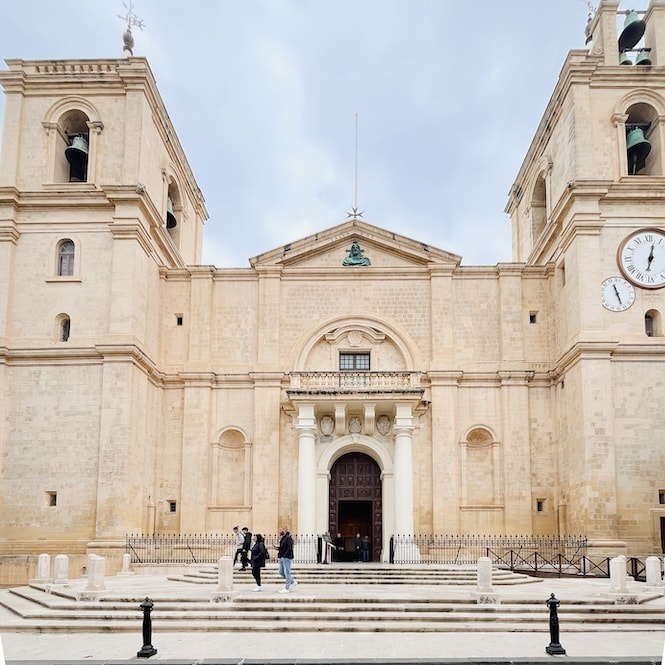
This stunning church was built in the 16th century and has been a place of worship ever since. The church looks rather modest from outside, but once you step inside, you’re surrounded by beautiful marble floors and walls.
It has eight magnificent chapels. Each chapel is decorated with works of art, giving you a glimpse into the church’s history. The ceilings are also adorned with intricate paintings, adding to the beauty and grandeur of the place.
The entire visit usually takes around an hour, so make sure you take your time and enjoy the experience.
Whether you’re religious or not, St. John’s Co-Cathedral is sure to leave you with an appreciation for the beauty and history of the church.
Explore the National Museum of Archaeology
Opening times: Wednesday to Monday, 9 am to 5 pm in Jan & Feb and 10 am to 6 pm from Mar to Dec
Entrance fee: €5 for adults, discounts provided for seniors, students and children (more details)
Location: Google Maps
The National Museum of Archaeology is in the Auberge de Provence on Valletta’s Republic Street (see number 14 on the Valletta city map). It is a superb example of Baroque architecture, constructed in 1571 as per the design of an architect Ġilormu Cassar.
The National Museum of Archaeology boasts an impressive array of artefacts. They span from the Neolithic period (5900-2500BC) until the early Phoenician period (8th – 6th Century BC).
You can find an exhibition of tools, coins, human and animal figures, pottery, and jewellery. Also, you will get a glimpse of how people lived in pre-historic times. Some of the museum’s most famous objects are the “Sleeping Lady” from the Hal Saflieni Hypogeum. Also, there is the ‘Venus of Malta’ from Ħaġar Qim.
Credit: “Venus of Malta” by Hamelin de Guettelet, licenced under CC BY-SA 3.0; “Sleeping Lady” by Jvdc, licenced under CC BY-SA 3.0
What to Do in Valletta – Visit Strait Street for Fun & Food
Valletta’s Strait Street is also known as Strada Stretta in Maltese. On the Valletta map, you’ll find it as number 15.
It has a long and fascinating history. Strait Street was a nightlife hub in the 19th and mid-20th centuries. American and British military men, often accompanied by Maltese, spent their nights there. Over time it evolved into an iconic representation of multi-culturalism in Valletta.
Strait Street was a bustling hub of activity and culture during its heyday. Live music, especially jazz, was a popular attraction.
Unfortunately, the street’s reputation was tarnished by drunkenness and prostitution. With time, its popularity declined. But don’t let that put you off because today, Strait Street is just as vibrant as it ever was!
Thanks to renovations, Strait Street was revived about a decade ago. It is home to some of Malta’s best restaurants, cafes, and pubs. The street’s revival has also seen a resurgence of live music. You can listen to jazz, folk, and even rock music playing in the many bars and restaurants.
After a full day of sightseeing, Strait Street is perfect for a great night out.
Food and Drinks in Valletta: My Top Picks
If you’re in Valletta and feeling hungry or thirsty, no worries. This city has fantastic spots for food and drinks. Check out my top picks below. I’ve visited them all many times and keep going back.
First up, Coffee Circus. This basement café has great coffee and delicious cakes. Watch your head on the way in! Try the Portuguese pastéis de nata and pão de queijo. The staff is super friendly, making it a place worth revisiting. It’s a must-visit spot for sure!
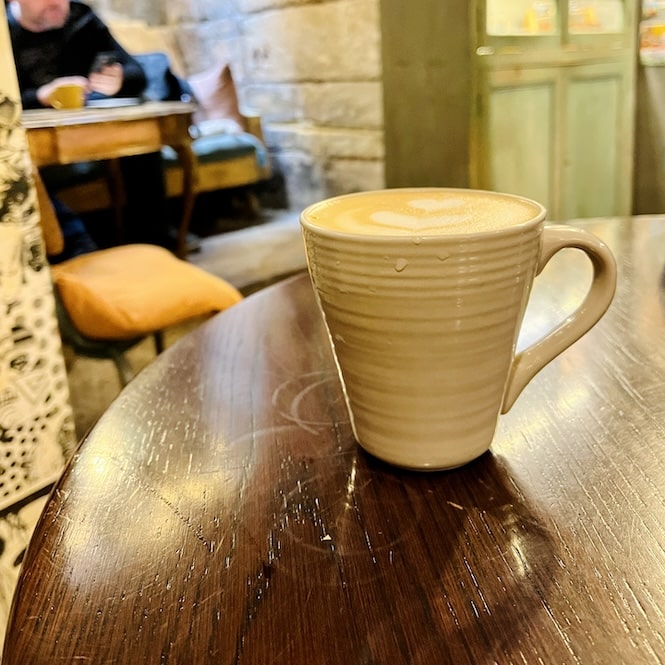
Then there’s Caffè Berry Valletta. I found this place at a friend’s suggestion. The pistachio drinks are amazing! They serve tasty coffee and cheesecakes. It’s a cosy spot not to be missed.
Lot 61 Coffee Roasters is another gem. They serve great coffee and delicious treats. Try the flat white, apple & ginger slice, and croissant.
For a dinner with a view, the Rooftop Restaurant & Lounge Valletta can’t be beaten. Perfect for a romantic evening watching the sunset in Malta. The food and atmosphere are excellent.
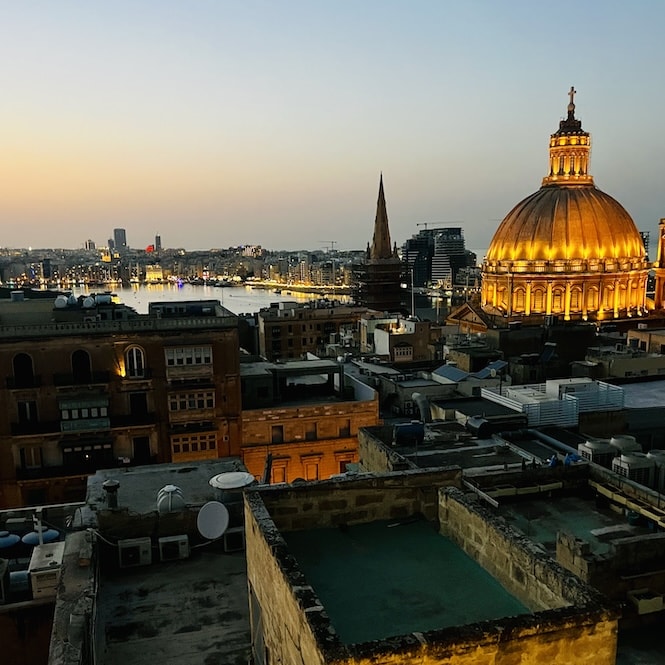
Prefer tapas? Iber&co offers top-notch Spanish cuisine and wine in a cosy, friendly setting. It’s small, so remember to book in advance.
And for pizza lovers, Sotto is amazing. They serve authentic Roman pinsa, which is so yummy.
So, those are my favourite spots in Valletta for meals or coffee. Each spot has something unique, so why not check them out?
Accommodation in Valletta
Staying in Valletta is unforgettable. The city’s historic houses, many hundreds of years old, have been converted into charming guesthouses and boutique hotels. Imagine waking up within thick, stone walls, then stepping out onto a balcony overlooking narrow streets teeming with history.
Also, staying in Valletta is very convenient for many reasons. Firstly, the city brims with dining options, ranging from charming local cafes to world-class restaurants. This means you’re never too far from an excellent meal or a cosy spot to unwind after a day of exploring.
Secondly, Valletta is a hub of activity. There’s always an event taking place, be it a music festival, art exhibition, or historical reenactment. Valletta is not just a place to stay, but a place to experience.
Thirdly, Valletta serves as a well-connected transport hub, making it easy to venture beyond the city’s walls and explore Malta. Frequent ferry services can get you to Sliema, the Three Cities or even Gozo.
There are many unique accommodations in Valletta, each with its personality. The houses have stayed the same, some have been modernised for a contemporary feel, but all have a story to tell.
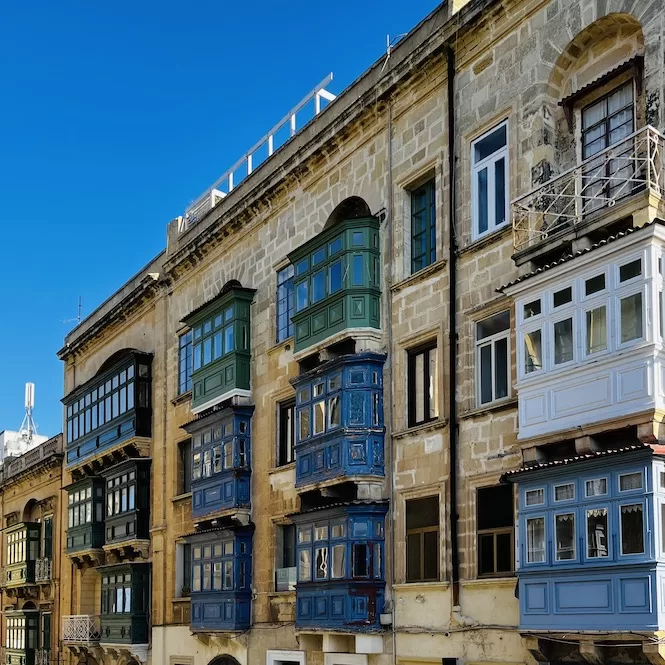
Authentic Places to Stay in Valletta
La Falconeria Hotel: Modern, spacious, and well-located in Valletta with a fitness centre, bar, and baby-friendly amenities. Book here.
Palazzo Jean Parisot Boutique Suites: Elegant apartments with a rooftop terrace and hydromassage tub. Book here.
Casa Ellul – Small Luxury Hotels of the World: 19th-century boutique hotel with authentic Maltese décor. Centrally located, and spacious. Book here.
Join my FREE private Facebook group, Malta Travel Tips, where you’ll find helpful resources and connect with other travellers just like you!
What to Do in Valletta: FAQ
How do I spend a day in Valletta?
Explore the key attractions in Valletta using a self-guided walking tour. I recommend choosing 3 to 5 attractions to visit, then relaxing in the gardens, enjoying coffee and lunch, and ending with dinner at one of Valletta’s many restaurants and bars.
Is Valletta worth a visit?
Valletta’s stunning architecture and rich history make it a top destination in Malta. As a UNESCO World Heritage Site, it offers a unique, multicultural history and is the top 1 destination in Malta. There are so many things to do in Valletta: visit museums, stroll the streets, relax in one of the gardens, enjoy coffee or a meal.
Is Valletta a walkable city?
Yes, Valletta’s compact size is suitable for walking. However, be prepared for uphill and downhill streets, especially if you explore from Republic Street towards the waterfront.
What is Valletta known for?
Valletta is famous for its history, Mediterranean views, and landmarks like Triton’s Fountain and Fort St Elmo. It was built by the Knights of St John. For more historical facts, check out my post on the top historical sites in Malta.
Is it expensive to eat out in Valletta?
Eating out in Valletta varies in price, with average meals costing between 15-25 euros. Options range from affordable sandwich places to upscale rooftop restaurants.
What is the most famous street in Valletta?
Republic Street is the most famous, leading to historic sites like St John’s Co-Cathedral and the Grandmaster’s Palace. Strait Street is popular for bars and dining.
What is the prettiest street in Malta?
For me, St Barbara Bastion is the prettiest, with beautiful buildings and a sea view.
What is unique about Valletta?
Valletta’s uniqueness comes from its rich military history, stunning architecture, and underground tunnels. It offers spectacular Mediterranean views.
Is one day in Valletta enough?
One day is enough to see the main attractions, but many visitors prefer one to three days for a fuller experience of the city’s museums and landmarks.
Can you walk around Valletta?
Yes, it’s walkable around the perimeter along the water, offering views of the Three Cities, Sliema, and fortifications. This less-travelled path promises a quiet time.
Is Valletta lively at night?
Valletta offers a vibrant nightlife with pubs and bars, especially around Strait Street and the Valletta Waterfront. Note that there are no clubs.
I hope you now longer wonder what to do in Valletta and found the Valletta map helpful. There’s so much to explore and enjoy in this vibrant city. You’re going to love Valletta.
If you’re putting together your Malta trip itinerary, you should check out my guide to top things to do in Malta. It’s packed with all you need to know – from top places to visit to the best beaches and even some hidden spots.
Don’t forget to explore other historical places such as Mdina, Rabat and Three Cities. For a day trip, here are my guides to the Blue Lagoon and Gozo. Also, learn about the best time to visit Malta so you can have an amazing experience.

